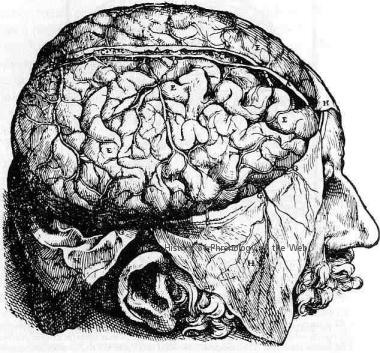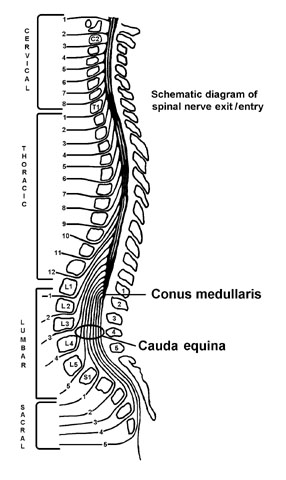
NERVOUS SYSTEM STUDY SEQUENCE
I Communication Systems
A. Nervous vs. Endocrine
II Nervous System Organization
A. Sensory --> Integration --> Motor
III Histology
A. Neurons and Neuroglia
III Central Nervous System
A. Brain
B. Spinal cord
C. Protection
IV Peripheral Nervous System
A. Somatic
B. Autonomic
1. parasympathetic
2. sympathetic
COMMUNICATION NETWORKS: NERVOUS SYSTEM
I Communication Systems
A. Nervous System
B. Endocrine System
C. Interactions
1. hypothalamus
II Nervous System Organization
A. Functional
1. sensory
2. integrative
3. motor
B. Anatomical
1. central nervous system (CNS): brain and spinal cord, interneurons
2. peripheral nervous system (PNS): nerves, sensory and motor neurons
III Histology
A. Neurons

1. characteristics
2. structure
a. cell body
b. dendrites
c. axon
1. hillock
2. axon terminal
3. myelin
3. synapse
B. Neuroglia
1. characteristics
2. function
3. CNS types
a. astrocytes
b. microglia
c. ependyma
d. oligodendrocytes
4. PNS types
a. Schwann cells
C. Nerve
1. definition
2. connective tissue wrappings
At the end of this unit you should be able to:
- identify the two main communication networks in the body and the major link between them
- compare their response and duration times
- diagram the relationship between the sensory, integrative, and motor divisions of the nervous system
- identify the structures of the nervous system used in each division
- distinguish between a glial cell and a neuron structurally and functionally
- diagram a neuron and label, cell body, dendrites, axon, axon hillock, axon terminal, myelin, synapse
- state the role of each of the parts of a neuron
- list and discuss the function of the glial cells of the CNS
- list and discuss the glial cells of the PNS
- describe the process of myelination
- describe the structure of a nerve
IV Central Nervous System
A. Brain
 Vesalius
Vesalius
1. Regions: in evolutionary progression
a. brainstem
1. medulla oblongata
a. basic survival functions
b. pyramids, decussation of pyramids
2. pons (�bridge�)
3. midbrain
a. cerebral peduncles (anterior)
b. corpora quadrigemini (posterior)
1. superior colliculi
2. inferior colliculi
4. reticular formation
a. Reticular Activating System (RAS)
b. diencephalon
1. thalamus (relay station)
2. hypothalamus (autonomic regulation)
a. mammillary bodies
b. infundibulum
3. epithalamus
a. pineal body (gland)
c. cerebrum (from deep regions to surface regions)
1. grey matter (cell bodies of neurons) - basal nuclei
2. white matter (myelinated axons)
a. commissural fibers (corpus callosum)
b. association fibers
c. projection fibers
3. grey matter - cortex
a. surface structures: fissures, sulcus, gyrus
b. general functional areas
1. sensory, motor, association
c. �mapping the cortex� : specific functional areas
1. primary motor cortex
2. premotor cortex (association only)
3. prefrontal area
d. cerebellum
1. structure: �lesser brain�, arbor vitae
2. coordination via cerebellar peduncles
a. superior (with midbrain)
b. middle (with pons)
c. inferior (with medulla)
At the end of this unit, you should be able to:
- list and identify the four general regions of the brain
- draw and label the three areas of the brainstem
- explain the function of the medulla oblongata
- describe the decussation of the pyramids and its significance
- describe the location, structure, and basic function of the pons
- list the structures of the midbrain
- discuss the function of the reticular formation and activating system
- list the three areas which connect the neurons of the cerebellum to the rest of the brain (peduncles)
- describe the location and state the function of the corpora quadrigemini
- identify the three regions of the diencephalon
- discuss the role of the thalamus
- locate the hypothalamus and list its functions
- locate the pineal body and state its function
- compare the composition of grey and white matter of the cerebrum
- identify the general areas of white and grey matter
- compare and contrast the association, commissural, and projection fibers
- define hemisphere, sulcus, gyrus, fissure
- identify the different lobes and landmarks of the cerebral cortex
- compare and contrast the structure of the cerebrum and the cerebellum
- explain the role of the cerebellum and how the peduncles are used for this role
B. Spinal cord
1. cervical and lumbar enlargements
2. spinal nerve numbering

3. conus medullaris; cauda equina
4. crossections
a. white matter; grey matter
b. dorsal root; ventral root
c. spinal nerve (mixed)
d. dorsal and ventral rami
e. ascending pathways; descending pathways
5. reflex arcs
C. Protection
1. bone
2. meninges
a. dura mater
b. arachnoid mater
c. pia mater
3. cerebrospinal fluid
a. function
b. circulation
1. choroid plexus, ventricles, subarachnoid space, sup. sagittal sinus
c. spinal tap
4. blood-brain barrier
At the end of this unit you should be able to:
- identify the regions of the spinal cord in a longitudinal section and a transverse section
- number the spinal nerves relative to the vertebrae
- describe a typical pathway an impulse takes from the periphery to the brain and back
- describe the pathway of a reflex and discuss the advantage to this pathway
- list the protections of the neural tissues of the CNS
- locate the three meninges and describe how they differ
- list the functions of the cerebrospinal fluid
- explain the location and role of the choroid plexus
- identify the ventricles of the brain and their connections
- describe the circulation pathway of the cerebrospinal fluid
- discuss a possible result of a blockage in the CSF pathway
- explain the structures and role of the blood brain barrier
V Peripheral Nervous System (PNS)
A. Somatic (aware and voluntary)
1. sensory input from skin and senses
2. motor output to skeletal muscles
a. single myelinated axon connecting CNS and skeletal muscle
B. Autonomic (ANS) (unaware and involuntary)
1. sensory input from internal organs
2. motor output to internal organs (heart, smooth muscle, glands)
a. two motor neurons in series
1. neuron #1: CNS ---> autonomic ganglion, myelinated
2. neuron #2: autonomic ganglion ---> to effector, unmyelinated
b. dual controls for fine-tuned regulation
1. sympathetic
a. �fight or flight� situations; prepare for energy output
b. neuron #1: thoracolumbar outflow to ganglion
1. sympathetic chain
c. highly branched fibers spread activity to large area
2. parasympathetic
a. �feed and breed� situations; restore and conserve energy
b. neuron #1: cranial-sacral outflow to ganglion
At the end of this unit, you should be able to:
- state the two main branches of the PNS
- compare the anatomical structures and connections of these two branches of the PNS
- compare the general functions of these two branches of the PNS
- state the two branches of the autonomic portion of the PNS
- compare the anatomical structure and connections of these two branches of the ANS
- compare the general functions of these two branches of the ANS
- explain an advantage to having two opposing neural connections to organs like the heart
return to Anatomy Outlines
return to Human Anatomy
return to Home page
Last Updated: 4/22/24